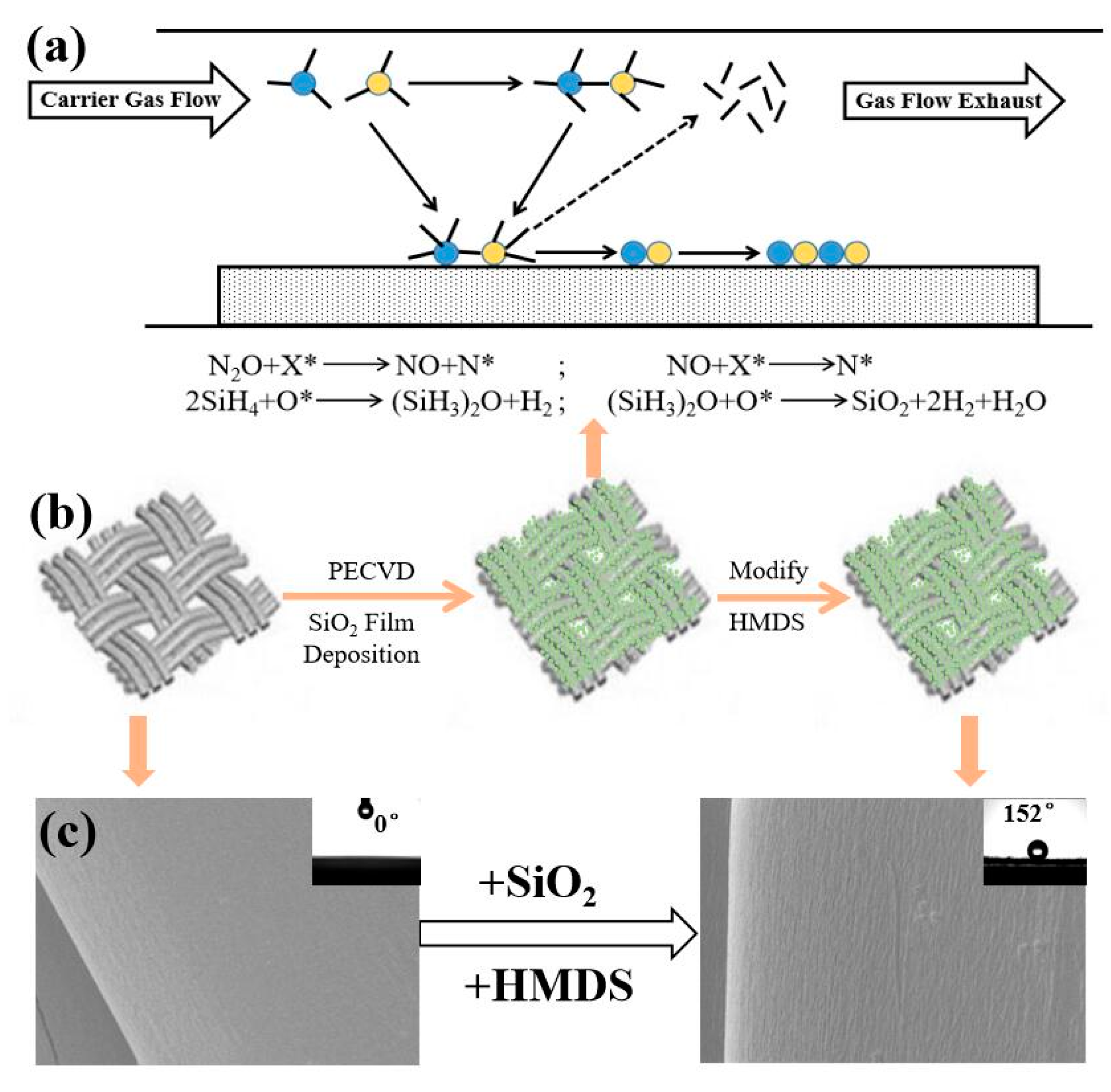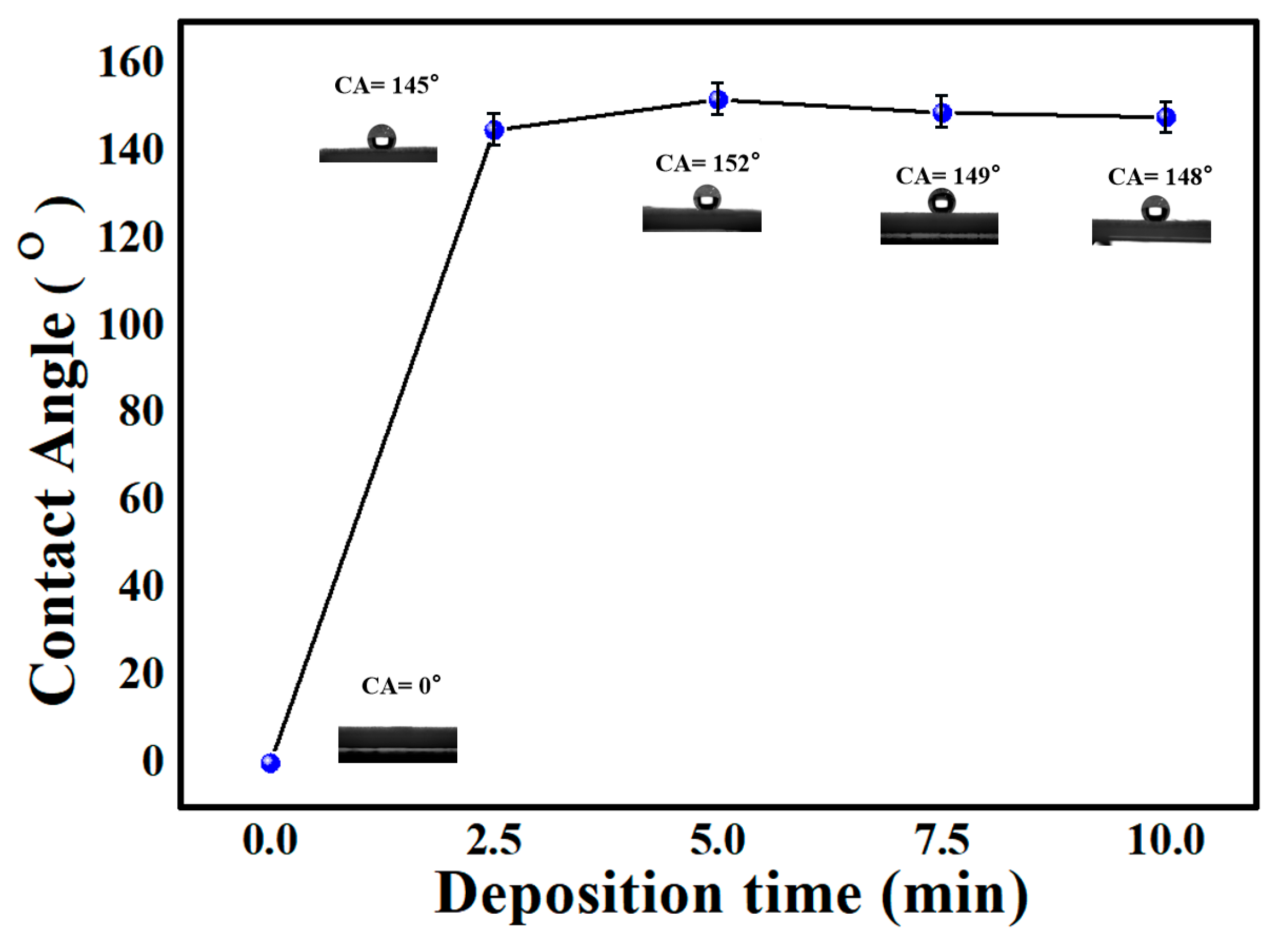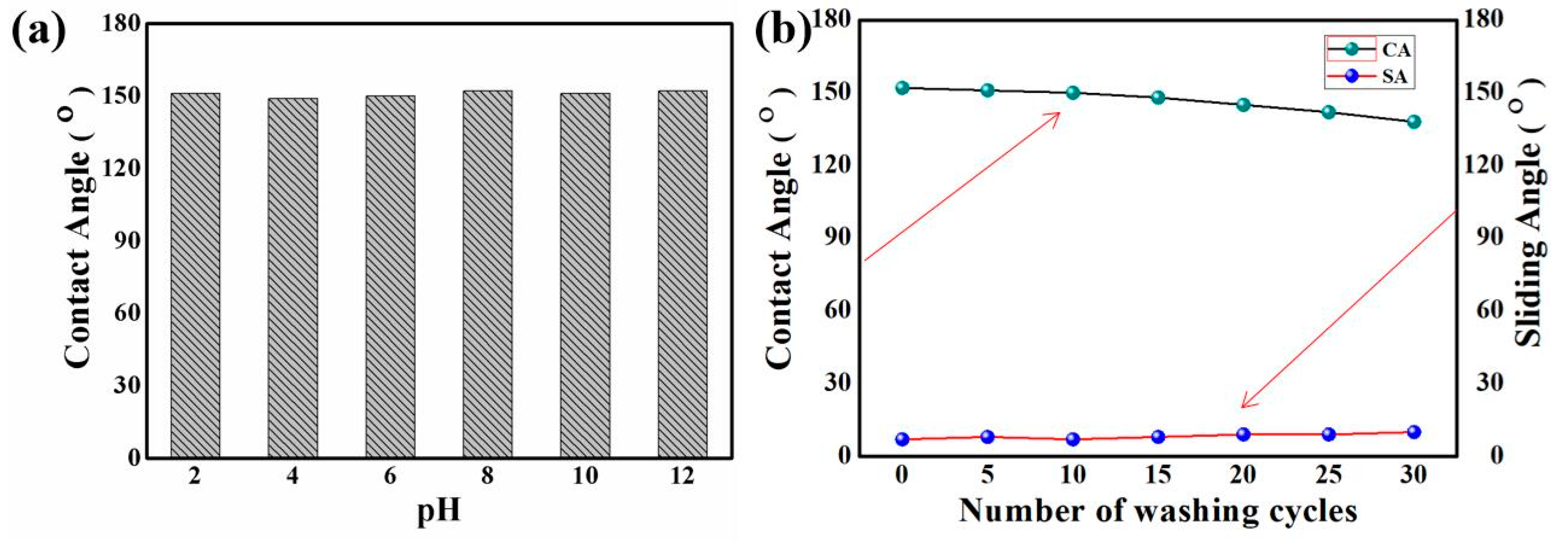Fabrication of Superhydrophobic and UV-Resistant Silk Fabrics with Laundering Durability and Chemical Stabilities
Abstract
:1. Introduction
2. Materials and Methods
2.1. Materials
2.2. Preparation of Superhydrophobic Silk Fabrics
2.3. UV Radiation Treatment
2.4. Characterization
2.5. UV Resistance Evaluation
2.6. Chemistry Stability Evaluation and Laundering Durability Evaluation
3. Results
3.1. Surface Morphology and Composition Analysis
3.2. Surface Wettability Analysis
3.3. UV Resistance Analysis
3.4. The Mechanical Properties Analysis
3.5. Chemistry Stability and Laundering Durability Analysis
4. Conclusions
Author Contributions
Funding
Conflicts of Interest
References
- Kim, D.H.; Viventi, J.; Amsden, J.J.; Xiao, J.L.; Vigeland, L.; Kim, Y.S.; Blanco, J.A.; Panilaitis, B.; Frechette, E.S.; Contreras, D.; et al. Dissolvable films of silk fibroin for ultrathin conformal bio-integrated electronics. Nat. Mater. 2010, 9, 511–551. [Google Scholar] [CrossRef] [PubMed]
- Shao, Z.; Vollrath, F. Surprising strength of silkworm silk. Nature 2002, 418, 741. [Google Scholar] [CrossRef] [PubMed]
- Altman, G.H.; Diaz, F.; Jakuba, C.; Calbro, T.; Horan, R.L.; Chen, J.; Kaplan, D.L. Silk-based biomaterials. Biomaterials 2003, 24, 401–416. [Google Scholar] [CrossRef] [Green Version]
- Rajkhowa, R.; Gupta, V.; Kothari, V. Tensile Stress-strain and Recovery Behavior of Indian Silk Fibers and Their Structural Dependence. J. Appl. Polym. Sci. 2000, 77, 2418–2429. [Google Scholar] [CrossRef]
- Jin, H.J.; Kaplan, D.L. Mechanism of silk processing in insects and spiders. Nature 2003, 424, 1057–1061. [Google Scholar] [CrossRef]
- Markus, H.; David, K.; Thomas, S. Spider Silk: From Soluble Protein to Extraordinary Fiber. Angew. Chem. Int. Ed. 2009, 48, 3584–3596. [Google Scholar]
- Yang, H.Y.; Yu, Z.W.; Li, K.; Jiang, L.; Liu, X.; Deng, B.; Chen, F.X.; Xu, W.L. Facile and Effective Fabrication of Highly UV-Resistant Silk Fabrics with Excellent Laundering Durability and Thermal and Chemical Stabilities. ACS Appl. Mater. Interfaces 2019, 30, 27426–27434. [Google Scholar] [CrossRef]
- Aslanidou, D.; Karapanagiotis, I. Superhydrophobic, superoleophobic and antimicrobial coatings for the protection of silk textiles. Coatings 2018, 8, 101. [Google Scholar] [CrossRef] [Green Version]
- Huang, J.J.; Yang, Y.Y.; Yang, L.; Bu, Y.M.; Xia, T.; Gu, S.J.; Yang, H.J.; Ye, D.Z.; Xu, W.L. Fabrication of multifunctional silk fabrics via one step in-situ synthesis of ZnO. Mater. Lett. 2019, 237, 149–151. [Google Scholar] [CrossRef]
- Ren, G.N.; Song, Y.M.; Li, X.M.; Wang, B.; Zhu, X. A simple way to an ultra-robust superhydrophobic fabric with mechanical stability, UV durability, and UV shielding property. J. Colloid Interface Sci. 2018, 522, 57–62. [Google Scholar] [CrossRef]
- Huang, J.Y.; Li, S.H.; Ge, M.Z.; Wang, N.Z.; Xing, L.N.; Chen, G.Q. Robust superhydrophobic TiO2@fabrics for UV shielding, self-cleaning and oil-water separation. J. Mater. Chem. A 2015, 3, 2825–2832. [Google Scholar] [CrossRef]
- Jiang, C.; Liu, W.; Yang, M.; Liu, C.; He, S.; Xie, Y.; Wang, Z. Robust multifunctional superhydrophobic fabric with UV induced reversible wettability, photocatalytic self-cleaning property, and oil-water separation via thiol-ene click chemistry. Appl. Surf. Sci. 2019, 463, 34–44. [Google Scholar] [CrossRef]
- Yang, H.; Wang, Y.; Liu, K.; Liu, X.; Chen, F.; Xu, W. Facile fabrication of ultraviolet-protective silk fabrics via atomic layer deposition of TiO2 with subsequent polyvinylsilsesquioxane modification. Text. Res. J. 2019, 89, 3529–3538. [Google Scholar] [CrossRef]
- Pai, P.G.; Chao, S.S.; Takagi, Y. Infrared spectroscopic study of SiOx films produced by plasma enhanced chemical vapor deposition. J. Vac. Sci. Technol. A 1986, 4, 689–694. [Google Scholar] [CrossRef] [Green Version]
- Signorini, C.; Nobili, A.; Siligardi, C. Sustainable mineral coating of alkali-resistant glass fibres in textile-reinforced mortar composites for structural purposes. J. Compos. Mater. 2019, 53, 4203–4213. [Google Scholar] [CrossRef]
- Xiao, X.F.; Liu, X.; Chen, F.X.; Fang, D.; Zhang, C.H.; Xia, L.J.; Xu, W.L. Highly anti-UV properties of silk fiber with uniform and conformal nanoscale TiO2 coatings via atomic layer deposition. ACS Appl. Mater. Interfaces 2015, 38, 21326–21333. [Google Scholar] [CrossRef]
- Lavelli, V.; Pagliarini, E.; Ambrosoli, R. Physicochemical, Microbial, and Sensory Parameters as Indices to Evaluate the Quality of Minimally-processed Carrots. Postharvest Biol. Technol. 2006, 40, 34–40. [Google Scholar] [CrossRef]
- Gao, Y.; Gereige, I.; El Labban, A.; Cha, D.; Isimjan, T.T.; Beaujuge, P.M. Highly transparent and UV-resistant superhydrophobic SiO2-coated ZnO nanorod arrays. ACS Appl. Mater. Interfaces 2014, 6, 2219–2223. [Google Scholar] [CrossRef]
- Khanzadi, M.; Jafari, S.M.; Mirzaei, H. Physical and Mechanical Properties in Biodegradable Films of Whey Protein Concentrate-pullulan by Application of Beeswax. Carbohyd. Polym. 2015, 118, 24–29. [Google Scholar] [CrossRef]
- Kubiak, K.J.; Wilson, M.C.T.; Mathia, T.G.; Carval, P. Wettability versus roughness of engineering surfaces. Wear 2011, 271, 523–528. [Google Scholar] [CrossRef] [Green Version]
- Nakae, H.; Yoshida, M.; Yokota, M. Effects of roughness pitch of surfaces on their wettability. J. Mater. Sci. 2005, 40, 2287–2293. [Google Scholar] [CrossRef]
- Chen, F.X.; Yang, H.Y.; Liu, X.; Chen, D.; Xiao, X.F.; Liu, K.; Li, J.; Cheng, F.; Dong, B.H.; Zhou, Y.; et al. Facile Fabrication of Multifunctional Hybrid Silk Fabrics with Controllable Surface Wettability and Laundering Durability. ACS Appl. Mater. Interfaces 2016, 8, 5653–5660. [Google Scholar] [CrossRef] [PubMed]
- Wang, S.; Zhang, Y. Preparation of the Silk Fabric with Ultraviolet Protection and Yellowing Resistance Using TiO2/La (III) Composite Nanoparticles. Fibers Polym. 2014, 15, 1129–1136. [Google Scholar] [CrossRef]







© 2020 by the authors. Licensee MDPI, Basel, Switzerland. This article is an open access article distributed under the terms and conditions of the Creative Commons Attribution (CC BY) license (http://creativecommons.org/licenses/by/4.0/).
Share and Cite
Liang, Z.; Zhou, Z.; Dong, B.; Wang, S. Fabrication of Superhydrophobic and UV-Resistant Silk Fabrics with Laundering Durability and Chemical Stabilities. Coatings 2020, 10, 349. https://doi.org/10.3390/coatings10040349
Liang Z, Zhou Z, Dong B, Wang S. Fabrication of Superhydrophobic and UV-Resistant Silk Fabrics with Laundering Durability and Chemical Stabilities. Coatings. 2020; 10(4):349. https://doi.org/10.3390/coatings10040349
Chicago/Turabian StyleLiang, Zihui, Zezhu Zhou, Binghai Dong, and Shimin Wang. 2020. "Fabrication of Superhydrophobic and UV-Resistant Silk Fabrics with Laundering Durability and Chemical Stabilities" Coatings 10, no. 4: 349. https://doi.org/10.3390/coatings10040349




